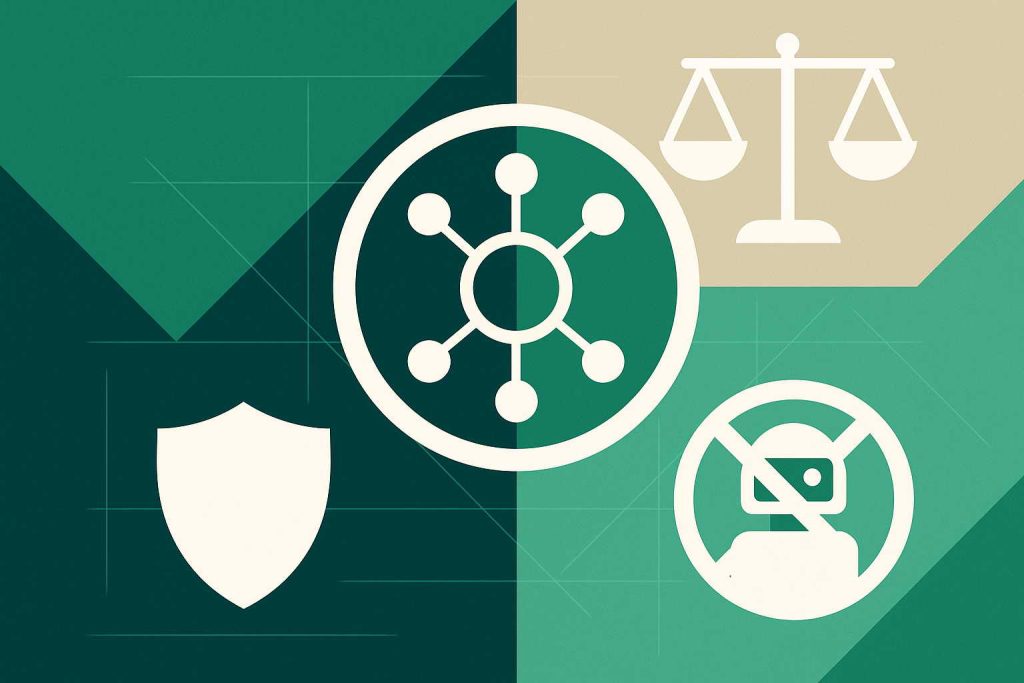This clause connects belief in القَدَرُ (al‑qadar, predestination) with personal responsibility. It guards against ٱلْجَبْرِيَّةُ (al‑jabriyya, fatalism) and the excuse that “the machine decided so”. Below is how to apply the norm without losing تَقْوَى (taqwā, God‑consciousness) or common sense.
Code Text
2.1.2. Predestination without fatalism
Divine predestination is acknowledged, yet human responsibility for choice and actions when using AI is preserved. It is forbidden to justify errors and abuses by appeals to inevitability or to the autonomy of technologies.
1) Sharia Foundations of the Clause
Belief in القَدَرُ does not cancel اِخْتِيَار (ikhtiyār, choice) or مَسْؤولِيَّة (mas’ūliyya, responsibility). Fatalism is forbidden: sin is not excused by “it was decreed”. Sound causes and means are part of توَكُّل (tawakkul, reliance on Allah) and do not contradict faith. Attributing an “independent power” to created things, including algorithms, is warned against. Safeguarding intellect and dignity belongs to مَقَاصِدُ ٱلشَّرِيعَةِ (maqāṣid al‑sharīʿa, higher objectives of the Sharia). Direct and indirect consequences of actions with AI fall under human responsibility.
2) Context and Benefit
Autonomous functions are growing, yet the human remains the moral agent. Fatalism in AI weakens risk control and undermines trust. A clear link “decision → responsible person” raises safety. Users receive clear rights and procedures. Product teams get explicit حُدُودٌ (ḥudūd, boundaries) and a shared language for communication. Organisations set up verifiable processes and audits.
3) Wording and Scope of Application
Clause § 2.1.2. The meaning is: affirm predestination while remaining responsible for choices and actions. The excuse “the algorithm decided so” is impermissible.
Where it applies. All civil AI solutions: chatbots, recommender systems, LLM (large language model), generative systems, fintech, education and telemedicine. Public statements, marketing and documentation are likewise covered.
4) Practice: Processes, Metrics, Oversight
Processes (minimum baseline)
- Responsibility matrix. A solution owner must be appointed for every function; links of “who approved what” must be recorded.
- Human‑in‑the‑Loop. A stage of human control must be defined for religiously and socially significant scenarios.
- Language & UX. Phrases like “AI made the decision for you” must be excluded; model limitations must be published in plain language.
- Incident reviews. A post‑mortem procedure must be defined without shifting blame onto the “autonomy” of the algorithm.
Compliance metrics (examples)
- Attribution Accountability Rate (AAR): share of releases/decisions with a named responsible person — 100%.
- Human Override Coverage (HOC): share of scenarios with manual override available — 100%.
- Incident Causality Clarity (ICC): share of reports attributing causes to human decisions/processes, not to the model’s “fate” — 100%.
- Disclaimer View Rate (DVR): share of screens/pages with an explanation of limitations — 100%.
Oversight
- Release audit. An audit of “non‑fatalistic” language in interfaces and documents must be performed.
- Decision audit. Samples of cases must be reviewed to detect the pattern “autonomy instead of responsibility”.
- Emergency rollback. A procedure must be ready to disable features in the event of mass errors harming users.
5) Examples of Correct Application (and Prohibited Cases)
Correct
- Notice: “The system is a tool. Decision‑making must be left to the human.”
- Log entry: “Recommendation approved by Analyst N; date; model version.”
- Credit‑scoring algorithm with a clear appeal procedure and manual review of contentious cases.
Prohibited
- Advertising claim: “The algorithm is always right.”
- Incident report: “Model autonomy is at fault,” with no analysis of human actions — prohibited.
6) Common Mistakes and How to Avoid Them
- Fatalistic language. Phrases like “the model decided” must be replaced by “the operator approved/did not approve based on a recommendation.”
- No right of appeal. A path for appeal and review must be described.
- Weak logging. Logs must be maintained that tie each action to a specific responsible person.
7) Short FAQ
May an error be written off to ‘predestination’?
No. Predestination does not cancel responsibility. Causes must be analysed and corrected.
Is full autonomy acceptable in sensitive tasks?
No. Human oversight and a right of appeal must be provided.
How should limitations be communicated to users?
Short explanations and links to a detailed policy must be published.
Disclaimer. This analysis is explanatory and is not a fatwā; priority is given to the text of the Code and to fatāwā of official scholars.



